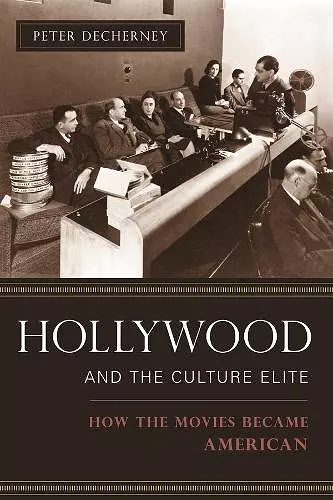Hollywood and the Culture Elite
How the Movies Became American
Format:Hardback
Publisher:Columbia University Press
Published:3rd May '05
Currently unavailable, and unfortunately no date known when it will be back

Peter Decherney explores how the concerns of intellectuals and the needs of Hollywood studio heads led to the development of a mutually beneficial relationship during Hollywood's Golden Age (1915-1960). During this period, museums, universities, and government agencies used films to maintain their position as quintessential American institutions, transforming movies into an art form and making moviegoing a vital civic institution. Decherney's history features an intriguing cast of characters, including the poet Vachel Lindsay, film producers Adolph Zukor and Joseph Kennedy, Hollywood flak Will Hays, and philanthropist Nelson Rockefeller. He shows how Columbia and Harvard started film studies programs in the 1910s and 1920s to remake American education and American culture. And he shows how the Museum of Modern Art, the U.S. Office of War Information, and the National Endowment for the Arts worked with Hollywood to fight fascism and communism and to promote American values abroad. Hollywood and the Culture Elite offers a unique glimpse into the collaboration between Hollywood and the stewards of high culture to ensure their own survival and profitability.
Hollywood and cultural institutions worked together to insure their own survival and profitability and to provide a coherent, though shifting, American identity. This book explores how their needs coalesced and led to the development of a symbiotic relationship between the film industry and America's stewards of high culture.As Americans flocked to the movies during the first part of the twentieth century, the guardians of culture grew worried about their diminishing influence on American art, education, and American identity itself. Meanwhile, Hollywood studio heads were eager to stabilize their industry, solidify their place in mainstream society, and expand their new but tenuous hold on American popular culture. Peter Decherney explores how these needs coalesced and led to the development of a symbiotic relationship between the film industry and America's stewards of high culture. Formed during Hollywood's Golden Age (1915-1960), this unlikely partnership ultimately insured prominent places in American culture for both the movie industry and elite cultural institutions. It redefined Hollywood as an ideal American industry; it made movies an art form instead of simply entertainment for the masses; and it made moviegoing a vital civic institution. For their part, museums and universities used films to maintain their position as quintessential American institutions. As the book delves into the ties between Hollywood bigwigs and various cultural leaders, an intriguing cast of characters emerges, including the poet Vachel Lindsay, film producers Adolph Zukor and Joseph Kennedy, Hollywood flak and censor extraordinaire Will Hays, and philanthropist turned politician Nelson Rockefeller. Decherney considers how Columbia University's film studies program helped integrate Jewish students into American culture while also professionalizing screenwriting. He examines MoMA's career-savvy film curator Iris Barry, a British feminist once dedicated to stemming the tide of U.S. cultural imperialism, who ultimately worked with Hollywood and the U.S. government to fight fascism and communism and promote American values abroad. Other chapters explore Vachel Lindsay's progressive vision of movies as reinvigorating the public sphere through film libraries and museums; the promotion of movie connoisseurship at Harvard and other universities; and how the heir of a railroad magnate bankrolled the American avant-garde film movement. Amid ethnic diversity, the rise of mass entertainment, world war, and the global spread of American culture, Hollywood and cultural institutions worked together to insure their own survival and profitability and to provide a coherent, though shifting, American identity.
It is in the author's discussion of these Cold War happenings that the narrative becomes almost cloak-and-dagger. Publishers Weekly A clearly written and well-researched historical work that makes a strong contribution to film scholarship. -- Heidi Kenaga The Moving Image A frequently profound ethical query into the costs of patronage. -- Kevin Hagopian Film Quarterly Thought-provoking. The American Historical Review Decherney does an excellent job exploring the individual players... and exposing how our current cinematic institutions and assumptions regarding film were founded. -- Erin Hills-Parks Film & History A very significant work that demands attentive and critical engagement. -- Tom Crosbie Screening the Past
- Runner-up for Theatre Library Association Award 2005
ISBN: 9780231133760
Dimensions: unknown
Weight: unknown
272 pages